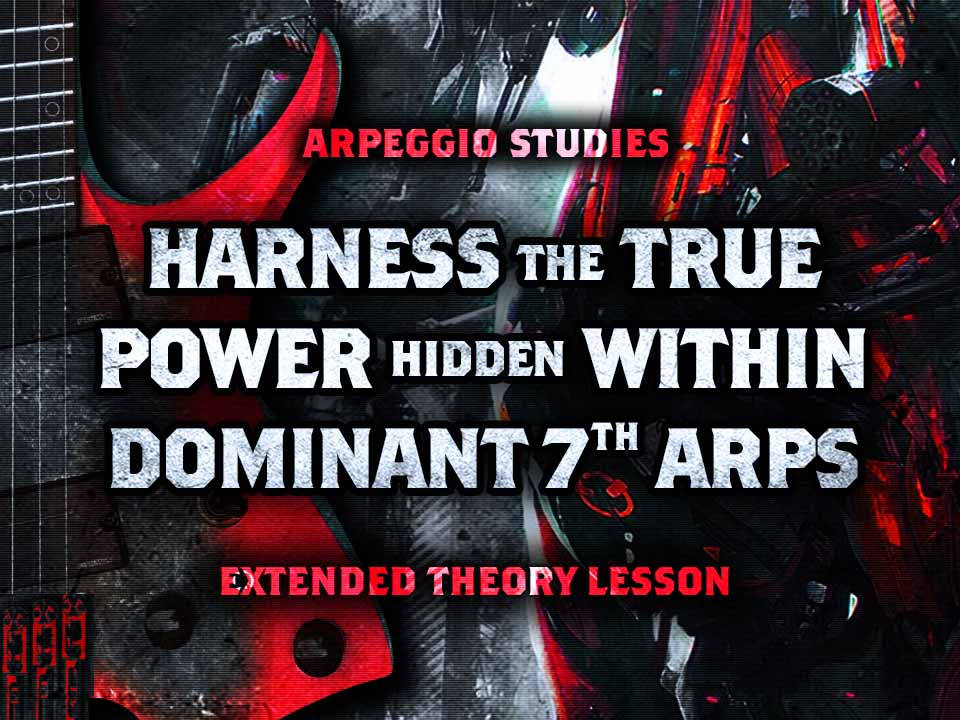Today we’re looking at a short arpeggio sequence that uses a 3 string minor 7 pattern. This arpeggio ascent works really well as a warmup. Let’s go over a few variations to help with our timing and coordination.
This Ascending minor 7 warm up is great because it gets all 4 fingers working in a way that isn’t chromatics. Further to this, beyond being just a warm up, this type of idea where we’re moving one arpeggio shape in different intervals is a great way to add ‘outside’ type flavours to your playing because it is essentially an unexpected key change.
Our ascending minor 7 sequence will start on an A minor 7 arpeggio using the shape below:
Once you get the hang of this sweep we can look at a sequence of arpeggios all played in the same way. Each one will be the same minor 7 shape but moved up the neck. Let’s look at three variations of the sequence. This will help you warm up when played at a medium speed. It will also be good practice for moving around the neck.

Contents for This Lesson:
Use these links to jump to the section of interest if you feel like skipping ahead!

Ascending Minor 7 Sequence Ex.1 – Triplets
In the first exercise we will be playing the arpeggio as a series of 8th note triplets. In a bar of 4/4 you would get twelve evenly spaced notes, You can count them as:
“One and a Two and a Three and a Four and a“
The numbers One, two, three, four are the beat and the “and” and “a” are the notes in between. Therefore we get 3 evenly spaced notes per beat, hence why they are called triplets.
Start on the Root note, A, at the 14th fret of the 3rd string. Next sweep the notes C and E on the 2nd and 1st strings. From this point we descend by up picking the note G on the 15th fret of the 1st string and continue sweeping the note C and then G on the 3rd string.
Once you get to grips with this arpeggio we can move it up the neck. First play it through twice, then move up so that the Root note (Red on the diagram) is at the 16th fret. Basically you’re moving every note up two frets. Play the shape here twice then move everything up one fret and play it twice. The Root should now be on the 17th fret G string. Finally we move up another two frets to the 19th fret G string and play the arpeggio twice more.
We have basically played Am7, Bm7, Cm7 and then Dm7. You can think of the first two arpeggios as being from the key of G Major, where Am7 is the ii chord and Bm7 is the iii chord. Then we change key to Bb Major so Cm7 is our ii chord and Dm7 is the iii chord.
Here is an example of how it should sound:

Ascending Minor 7 Sequence Ex.2 – Sixteenth Notes
The next sequence will be exactly the same arpeggios, but we’re going to play them a little differently. This time around, start on the 12th fret of the 3rd string and then hammer on to the root note at the 14th fret. Now we ascend as before playing C on the 11th fret of the 2nd string followed by E on the 12th fret of the 1st string.
The next part is slightly different to the triplet version too. As before we will up pick the G on the 15th fret only this time we will then pull off back to the E at the 12th fret. Then play C on the 2nd string followed by A on the 3rd string.
If you have done this correctly you will have played 8 notes in total. Repeating the sequence will give you a whole bar of 16th notes. You could also play this as 8th notes and one repetition will fill a whole bar of music.
Now we will repeat the same progression. First move everything up two frets so that you are starting by hammering on from the 14th to the 16th fret of the 3rd string. Again we’re playing the same sequence of notes, just all moved up by two frets. Next we move the whole thing up one fret and then finally another two frets.
This one should sound like this:

Ascending Minor 7 Sequence Ex.3 – Alternating timing
After playing through the first two exercises a few times each you should find your hand is starting to feel warmed up. Now we are going to alternate between the triplet version and the 16th note version.
Being able to change timing is important. This is because if you play long passages in your music where the timing of the notes never changes it will start to sound monotonous. The listener may start to “zone out”.
By incorporating a timing change in your warmup it also forces you to think more about what you are doing. This should help you to stay focused and not go into auto pilot whilst warming up. Being able to switch between triplets and straight 16th notes will open up more possibilities for playing interesting and complex passages.
Start by playing the Am7 Arpeggio as described in Ex.1. when we move up to the Bm7 we’ll be playing the Ex.2 version. then for the Cm7 we go back to triplets and finally 16th notes again for the Dm7.
Here is an example:
That’s it for this one! This warmup will help your fretboard hand dexterity. I reccomend combining it with other warmup licks that work the picking hand too.
You can build speed fairly quickly and easily with this arpeggio, once properly warmed up. Since it is relatively easy and sounds good it will also help you start your guitar practice with a positive mental attitude. Its important to feel good about your playing to help keep you motivated.
As always start off slow and have fun with it! Try adding in little ending licks once you get the the last arpeggio or even combine these ideas with other arpeggios.
Syndicate Member Downloads:
All Axe-cess members can download the guitar pro tab for this lesson. Click or tap the image link below. A full video lesson can also be accessed via our Patreon page.


Checkout some of our other lessons below!
















No Comment